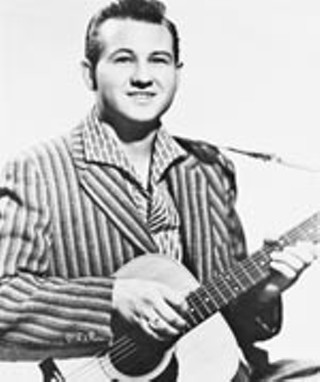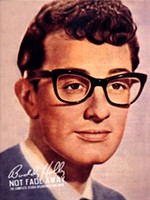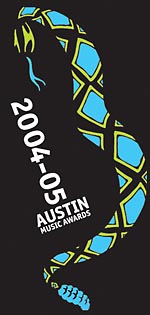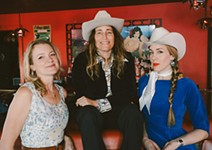Love Is All Around
Sonny Curtis fought the law and won
By Raoul Hernandez, Fri., Oct. 15, 2004

Tracked for three months and through as many states, following phone calls, e-mails, rendezvous hit and missed, onstage and off, over meals lavish and sandwich, on the very last question of an intensive two-day interview, Sonny Curtis expresses uncharacteristic doubt.
"I don't ... know," he says haltingly, comfortably arm-chaired just inside the lush greenery of Tennessee, 35 minutes from the doorstep of Music Row. "It's not really eerie. It strikes me as how fortunate I am to have been a part of that, and to have known Buddy. You know, I really wonder from time to time if I'd amounted to anything if I hadn't crossed paths with Buddy. He was a giant catalyst for a whole bunch of stuff. Would there be any Beatles without Buddy? Who knows?"
The buffeting tom-toms and bell-ringing jangle of El Paso's Buddy Holly wannabes, the Bobby Fuller Four, they had no doubts according to their 1965 cover of "I Fought the Law," thundering down the halls of punk rock's 1977 season on the hoofs of the Clash. A quarter-century later, odds are Buddy Holly never even crossed Green Day's mind.
"It was a deal with this girl in New York," chuckles Curtis. "This girl, real sweet little girl, she's about 16, something like that. This girl actually got busted for downloading songs. iTunes got in cahoots with Pepsi 'cause they were doing a deal where you could download and it wouldn't be against the law. She says, 'It's a great deal with iTunes 'cause I've learned my lesson. I've already been busted once.'

"'I Fought the Law' is the song playing."
Curtis, 67, the embodiment of West Texas congeniality, beams.
"Great commercial. Played at the Super Bowl and the Academy Awards. Green Day did a terrific job. You'll find that most of the time someone does one of your songs, you like it."
Phil and Don Everly needed no convincing in 1961 when they took "Walk Right Back" up the pop charts, nor does Nanci Griffith 43 years later every time she duets with Curtis on "More Than I Can Say." Most notably, of course, to James L. Brooks and Allan Burns, creators of The Mary Tyler Moore Show, Sonny Curtis walks in no man's shadow.
"A shit-kicker kind of guy it seemed," offers Burns in a documentary on the landmark TV series' first season DVD. "He put his guitar down, opened the case, had some pages of lyrics, put 'em down on the guitar case, and played the song. He finished and we looked at each other: 'How did we get this lucky?'"

Curtis no doubt prefers the descriptor "good ol' boy," but as the man who wrote and sang "Love Is All Around," you can call him Sonny.
Breaking Rocks in the Hot Sun Amid the myriad all-star pairings of Eric Clapton's three-day Crossroads Guitar Festival in Dallas, June 4-6 ('TCB,' June 11, 2004, Music) – Clapton and J.J. Cale, Clapton and Santana, Clapton and Jeff Beck – a "Guitar Pull" at the Guitar Center Village indoor facilities Saturday afternoon was all too easy to sneeze past on the schedule.
Pity, because that's where Riders of the Purple Sage trail boss Buck Page, Dylan forerunner Ramblin' Jack Elliott, and a couple of pickers from Nashville, Curtis and Norm Stephens, swapped songs for 90 minutes. Off to market for auctioning, Stevie Ray Vaughan's prize guitar, "Lenny," was on display nearby, but Lone Star history was alive and well every time Curtis' turn came 'round.
His initial go-round, May 9, 1937, came seven miles southeast of Meadow, Texas, population 408. Curtis, the fifth of six children, remembers Meadow lying 28 miles south of Lubbock, "from courthouse to city limits sign."
"I was born in a dugout," he exclaims. "My dad dug a hole in the ground, put a corrugated tin roof on top of it, and that's where I was born. I beat my sister ahead of me. She was born in a tent!"

The Curtis' shotgun shack, one room, 12-by-14 feet, occupies prime real estate in Sonny's memory. There was a bed, off which Arthur Lee Curtis and the former Ms. Violet Cleo Moore took the mattress for their brood (the three girls at the head, boys at the foot), plus his mother's trunk, and a wood-burning stove. Their neighbors, tangles of mesquite, kept the "house" heated in winter. Summers, the family worked cotton on grandad's farm and slept under an endless sky.
"'Course there was no lights," he adds. "I can still remember in the summertime, late, late at night, man. I could hear the coyotes howling, and it was real mournful."
The wife of his dad's brother, Aunt Lorena, her brothers were from Dimmitt, Texas. Ranchers, real stout.
"Real stout," emphasizes Curtis. "Still are, man – cowboys."
They loved to pick, those Mayfield boys. Ed Mayfield, a rodeo cowboy torn between ranching and picking, died on the road as a member of Bill Monroe's band. Smokey Mayfield favored the fiddle. Sonny learned to both pick guitar and pluck fiddle, eventually focusing his energies on the former when he went into the Army in 1960. Naturally, his was a country 'n' bluegrass upbringing: Monroe, Ernest Tubb, Flatt & Scruggs, Hank Williams, Eddy Arnold, Bob Wills, Sons of the Pioneers. Buck Page's Riders of the Purple Sage.

In Dallas, as a matter of fact, Page's vintage rendition of Sage cover "Ghost Riders in the Sky" almost steals Curtis' well-manicured acoustic thunder on "I Fought the Law." Recorded in 1959, days after Buddy Holly's funeral, "I Fought the Law" appeared on the Crickets' post-Holly debut, In Style With the Crickets. J.I. Allison and Joe B. Mauldin had taken their leave of Holly, hooked up with their old running buddy Curtis, and cranked out "I Fought the Law" and "More Than I Can Say." Curtis is down with the Clash's rumbling remake of "I Fought the Law," but gives the edge to Hank Jr.'s take.
"The song came quick," remembers Curtis. "I was in the living room, in Slaton, Texas, where I lived at the time. It was one of those West Texas afternoons where the sand was blowing, those days you have in the spring. Probably March 1958. I wrote it in 15 minutes – bam! If you listen to it, you can tell you don't have to be a rocket scientist to write those lyrics."
You don't have to be a rocket scientist to gum them up either.
"The line that says, 'Robbing people with a zip gun'? Most people don't know what a 'zip gun' is. Bobby Fuller said, 'Six-gun,' so everybody says 'six-gun.' You know the old zip guns, tape 'em together – pipe and wood? I'd read some article at the time, about zip guns. It's funny no one ever picked up on it. That's rock & roll for ya."
Is that what you call hearing it on Super Bowl and Academy Awards broadcasts?

"It's kind of surreal, yeah," says its composer, shaking his head. "What's even more surreal is that somehow or another ... this check makes it to my mailbox."
Fool's Paradise
The Hives are in the house. At the Grafton on Sunset in Los Angeles, two blocks from the House of Blues where The Crickets & Their Buddies (Sovereign) celebrates its CD release on this mild August night, Sweden's heirs to Buddy Holly have hit the noon checkout. Dr. Matt Destruction is out of regulation Hives black and white, as is singer Howlin' Pelle Almqvist, who breezes past with Maria Andersson of fellow Swedes Sahara Hotnights. Drummer Chris Dangerous struts by in a Fifties-issue hot-rod jacket with his name stitched across the back. That's rock & roll for ya.
Cruising either direction on this stretch of Sunset Strip is exactly that. There's the Whiskey a Go-Go up the street, across from the Viper Room. Down the block, there's the House of Blues, Chateau Marmont, and continuing for several miles, the Hollywood Bowl, best record depot in the known universe, Amoeba Records (hello, Young Heart Attack), and the Capitol Records tower. Police routinely stop traffic for camera crews towing actors; they also keep the paparazzi off Laura Dern at a Directors Guild of America premiere (hello, Ben Harper). On the strip, everyone's a star, badly dressed as they are; hip-hop culture meets goth. The boobs are all fake and so are the majority of breasts. Welcome to the jungle. Perhaps this explains Curtis' parting words from Tennessee: "I'll have my gun with me, of course."
"Loosey-goosey" is his prediction for tonight. Albert Lee, Nanci Griffith, Rodney Crowell, Johnny Rivers, Bobby Vee, Tonio K., Peter Case, and Vince Neil are all reprising turns taken at the Crickets' catalog on the new disc. It's the trio's first recording since backing Griffith on "Well ... All Right" for 1996's Not Fade Away (Remembering Buddy Holly), starring, among many others, Joe Ely and Todd Snider's dashing "Oh Boy!"
It was Griffith, through famed C&W dramatist Harlan Howard, who helped reunite Curtis, Allison, and Mauldin after almost a decade, '85-'94, during which time the band continued with another singer. Not Fade Away also resulted in the Crickets backing Griffith on a yearlong tour. Buddy Holly's bassist on the last tour, Waylon Jennings, plays Griffith's part on The Crickets & Their Buddies, offering "Well ... All Right," companion to his collaboration with Mark Knopfler on Not Fade Away's out-of-body "Learning the Game." Jennings' widow Jessi Colter is a no-show at the House of Blues.
"Welcome to our show," waves the evening's emcee – Curtis – following the opening kick of "Oh Boy!" "It may resemble a free-for-fall," he laughs uncertainly.

Later, Curtis agrees that rounding up all the guests for rehearsal that day, let alone the gig, was a nerve-wracking experience, but from the floor of the HoB, it's all larger than life. Crowell and Lubbock Hall of Famer Bobby Keys snazz up "That'll Be the Day," while "Everyday," via J.D. Souther, is remarkably poignant. Curtis' run through "Peggy Sue" is fresh, but Griffith all but steals the spotlight on "Heartbeat," duets with Bobby Vee ("Blue Days, Black Nights") and Curtis ("More Than I Can Say"), and her contribution to Not Fade Away.
"My first recollection of TV was when I was 4," proclaims the songbird in her 4-year-old's chirp. "We loaded up the car to go see our boys from West Texas on Ed Sullivan. All I ever wanted to be was a Cricket."
Tonight, Griffith is queen Cricket, though of course Eric Clapton remains God.
"The first album I bought – ever," testifies the special guest/guitar deity toward the end of the performance, "was The 'Chirping' Crickets."
Clapton's delivery of "Someone, Someone," "Fool's Paradise," and "Think It Over" pays tribute to its relevance amongst London's teens of the era. Little wonder why J.I. Allison put out one of the first feelers for The Crickets & Their Buddies to the UK guitarist, who years before had expressed interest in such a project.

"It was our manager Bert Stein's idea, this album," explains Curtis. "You know, run it up the flagpole and see if anybody salutes it."
At the House of Blues, the sold-out room gives it 21 guns. Even Mötley buffoon Vince Neil, who warrants execution for his version of "I Fought the Law," recorded and live, can't dampen the deep nostalgia, though he does his damndest by making the band run through "Smoking in the Boys Room." First encore "Love Is All Around" provides the antidote. The boomers appear bewildered by the tune's inclusion, delighted nevertheless.
"That's one of the beauties of doing that song," nods Curtis. "There's a bit of a shock value: 'What are they doing this song for!?'
"And I tell ya what. ... I do pretty good with finger-style stuff. I have my limitations. I'm not a great rock-blues player like Eric. But man, pickin' with Eric is some of the most fun I've had in a while!"
Who Can Turn the World On With Her Smile?
Upstairs in his office, Curtis demonstrates the interplay of his home studio – 8-track, keyboard, guitar – but in the bright morning light of this low-ceiling corner room, mostly bare walls draw the eye to a splash of orange behind a nothing frame. Even if you can't quite read the document's print from across the room, an inscription in bold ink across the bottom left corner tells you what it is before you can cross the carpet to get a better look. Sheet music for "Love Is All Around."
Dear Sonny,

A good part of who I am comes from your poetry. Thank you for the 'Love.'
Mary Tyler Moore
"I had just bought a house in L.A.," recalls the poet, downstairs. "Before I got married. Louise and I were going together. I was at home, just sitting around pickin' one morning. This friend of mine, Doug Gilmore, who worked for the Williams & Price agency, called me and said, 'They're doing a sitcom with Mary Tyler Moore and they want a theme song. Would you be interested?' I said, 'Ah, man, sure.'
"That was about 11am.
"At noon, during his lunch break, he dropped off a four-page format that described the show. It wasn't a script, just a description. I've always thought that was kinda lucky, because they didn't give me a lot of information. It just said, 'A girl from the Midwest moves to Minneapolis.' She got jilted I believe. 'Moves to Minneapolis, gets a job at a newsroom, gets an apartment she has a hard time affording.'

"You know, that kinda stuff.
"So I sat down and started thinkin' about what to write. By about 2pm, I had one verse. I called [Gilmore] and said, 'Who do I sing this to?' He sent me – not far from my house – over to Studio City, the CBS soundstage. He sent me over to see James L. Brooks.
"There was this huge room that had no furniture in it. We met in that room, and he was rather cold to me. He said, 'I'll listen to what you've got, but we're not near this stage yet of choosing a theme song.' So I said, 'Well ... okay.'
"He had a couple of iron chairs sent in. I sat down and sang him the song, the one verse – which is all that's on the show. After I got the deal, I wrote another verse, lengthened it just in case for a record. There was a phone, a black phone sitting on the floor. He got on the wire and called somebody and said, 'Come down and listen to this.'
"Before I left, I had sung it about 10 times and the whole room was filled with people lined up all around the walls. Then he sent out for a cassette recorder. He said, 'I want to take this song with me to Minneapolis.' They were going up that weekend to do the [show's titles]. He said, 'I want this song with me.'

"By that point, I felt pretty good about it. 'Maybe I got something there.'
"It was a one-day deal from start to finish."
Fifty-four seconds of television immortality to be precise, 1970, the deal of a lifetime. Seven seasons on CBS and more than two decades of syndication for The Mary Tyler Moore Show have been kind to Curtis. Louise and her beau also enjoyed the cast party at Allan Burns' ("lovely guy") for the series' debut. On cue, Curtis' partner in the song's publishing, J.I. Allison, living just down the woods, not far from Joe B. Mauldin, calls with news that a product deal involving "Love Is All Around" has just come in.
"They wanted to know what companies have used it in the last 15 years or so," relays Curtis. "AT&T did one, I think. Home Depot has been using it."
Ever heard Hüsker Dü's version?

"Yes," grins Curtis. "I can't remember where I heard it, but I have heard it. Ever hear of the Dead Kennedys? They did it, too. It's been a real good copyright for me."
It's become a feminist touchstone, after all.
"Nanci says the same thing. She likes to sing that song with me."
With Louise's lunch for three comes an afternoon shower that washes clean downtown Nashville for Sonny's SUV tour through the capital. Ryman Auditorium, Fort Nashborough, where settlers crossed the frozen Cumberland River, and a statue of World War I sharpshooter Sgt. York illustrate Curtis' anecdotes about Marty Robbins, Chet Atkins, and the time his friend Roger Miller was on Hollywood Squares.
"'Can sheep be hypnotized?' they asked him, and he said, 'You don't need to, you just put their hind legs in your boots ...'"

Seems that sometimes, love is standing in your size 12s.
The Wind's Dominion
Even with the population at 825 – 16 miles out of Lubbock on Highway 62/82 – Meadow, Texas, is but a hiccup in the road. Locating Sonny Curtis Street is no harder than pulling off the highway. It's the main drag, and there's only one. On this intoxicating West Texas Sunday morning, fresh from the annual Buddy Holly Symposium in Lubbock ('TCB,' September 10, 2004, Music), we encounter a sole vehicle and not a single other soul.
In this stillness, you can hear Curtis' calfskin voice, the easy jaunt of his three solo LPs for Elektra Records, Sonny Curtis (1979), Love Is All Around ('80), and Rollin' ('81), which yielded "turntable" hit "Good Ol' Girls." That was the Waylon era, '79-'84, the Crickets opening for and guesting their ol' alum.
"When we moved to Nashville, we of course got mixed up with Waylon. We knew Waylon back in high school. Waylon and I used to pick in between movies at theatres. We'd do 10 minutes and make $10-12 apiece. Waylon was a deejay on KLLL in Lubbock, and he'd say, 'Okay, over in Littlefield tonight, Sonny and I are gonna be there pickin'.'"
That bicentennial relocation, after the birth of the Curtis' daughter Sarah, wasn't exactly daddy's inauguration in Nashville.
"Remember in the movie, The Buddy Holly Story? Did you see it? In the movie, Buddy – Gary Busey – punches out Owen Bradley in the studio. They had a fistfight. Can you imagine? That's the most ridiculous thing in the world. I mean, Owen Bradley was the nicest guy in the world. We were just kids from Lubbock, Texas. We were putting on our best manners, our best foot forward: 'Yes sir, Mr. Bradley. No sir, Mr. Bradley. Whatever you say, sir.'

"The idea that they'd take that sort of ugly license in a movie is really aggravating."
For the real Buddy Holly story, consult Curtis' "The Real Buddy Holly Story" on The Crickets & Their Buddies, but the short of it begins in a place native son Butch Hancock once termed The Wind's Dominion, Lubbock, 1952. Curtis, living "hand-to-mouth," used to hitchhike north to what music history today records as an archeological hub out of which was birthed a quantum leap in rock & roll evolution. Curtis had won a Lion's Club talent contest in Brownsville, witnessed by a Lubbock TV host, who booked (and rebooked) the 15-year-old guitarist onto his program. A pair of locals caught the appearances, and a mutual friend from Meadow passed along their desire to meet.
"He says, 'Man, there's these guys, Buddy and Bob [Montgomery], that play assembly programs at the high school.' I told them about you, and they said, 'Ah, man, we'd like to meet him.' I told him that I'd love to meet them, too.
"So we drove out there, and waited for the school bus to come drop Bob off. It was a windy afternoon. Most things I remember, the wind was blowing, the sand was blowing. When Bob got off the school bus he says, 'We gotta go over and see Buddy right now!'
"We went over to Buddy's house and I remember going in and Bob saying, 'Hey Buddy, this is Sonny Curtis.' We introduced ourselves, and said, 'Let's play.' No small talk, just, 'Let's pick.' We didn't say 10 words. We just broke 'em out and started picking. It was great fun."
The three, and often, just the two – Buddy and Sonny – played together off and on until 1955, when another seismic shift in rock & roll was occurring.
"Elvis came to Lubbock four times," waves Curtis. "The first time, there was just three of them, he and Scotty and Bill. It turned our heads around, especially Buddy. He said, 'Man, oh, man. This is what I want to do.' So, we started doing Elvis tunes. Buddy also started listening to rhythm & blues, more black-oriented music. I used to spend the night at Buddy's. We'd go out to the car at midnight and listen to Stan's Record Rack from Shreveport, and they'd play Lonnie Johnson, Ray Charles, Little Richard – all that stuff."
The Lubbock crew opened one of those Presley flybys, and eventually Holly landed a recording contract with Decca, producing a number of prestardom sessions with Owen Bradley. Their rockabilly of Curtis' "Rock Around With Ollie Vee" on MCA's comprehensive, 2-CD The Buddy Holly Collection is thought by Fender to be one of the first uses of the Stratocaster on a rock & roll track.
"We were kinda Elvis clones. I played that Chet lick kinda like Scotty Moore. They didn't even let Buddy play guitar. He sang. As good a guitar player as he was, he just stood there and sang. I think, and don't construe this as me thinking I'm the reason the Crickets made it, but when I left the group – to go on the road with Slim Whitman – Buddy started playing that really powerful rhythmic lead style. He had to; he was the only guitarist. I think that was a style waiting to happen."
In hindsight, so was everything after 1956. Curtis, meanwhile, made his way to Nashville, L.A., and New York, where he ran into the Crickets two years later.
"Sure, I felt a little left out, a little lonesome at the time. ... But when I got back to Texas, J.I. called me and said, 'Buddy's moving to New York, and Joe B. and I have decided to stay in Texas. Why don't you pick with us.'
"That's when I got back with the Crickets."
Come the new year, 1959 – February 3 – and Buddy Holly was dead. Within days, the Crickets had cut "I Fought the Law." Curtis moved to Los Angeles in 1962 after a two-year stint in the Army, where he wrote "Walk Right Back." In 1976, after considering a move to Austin (hello, Floyd Domino), Curtis settled in Jimmie Rogers' other "T."
Which brings us back to that last interview question, the one where Sonny Curtis wonders if he'd amounted to anything had his path not crossed Buddy Holly's.
Do you find it strange that 45 years after Buddy's death, audiences like the one in L.A. are essentially celebrating a moment frozen in time? A 22-year-old frozen in time.
"I've definitely always tried to be my own person," pauses Curtis, finishing his thought. "Even though I sing Crickets songs that Buddy sang, I've never tried to imitate Buddy. When we do a performance, we're obligated to do 'That'll Be the Day' the way folks remember hearing it. I don't overplay the hiccup part, but I put that in there, because it fits, it belongs.
"But I try to insert myself, because I wouldn't do it any other way. I always try to be my own person. I take from music all I can, and I give back as good as I can."
Undoubtedly. ![]()









